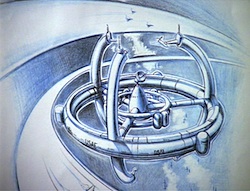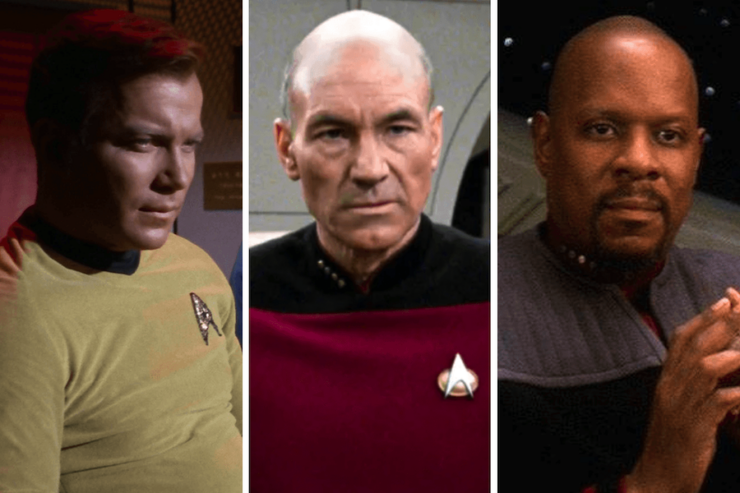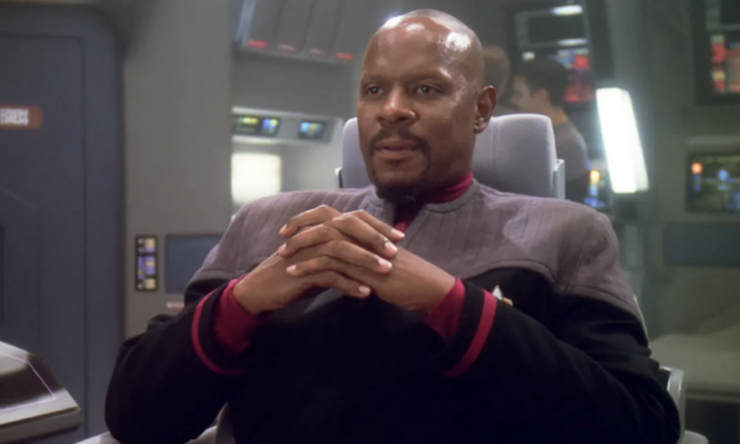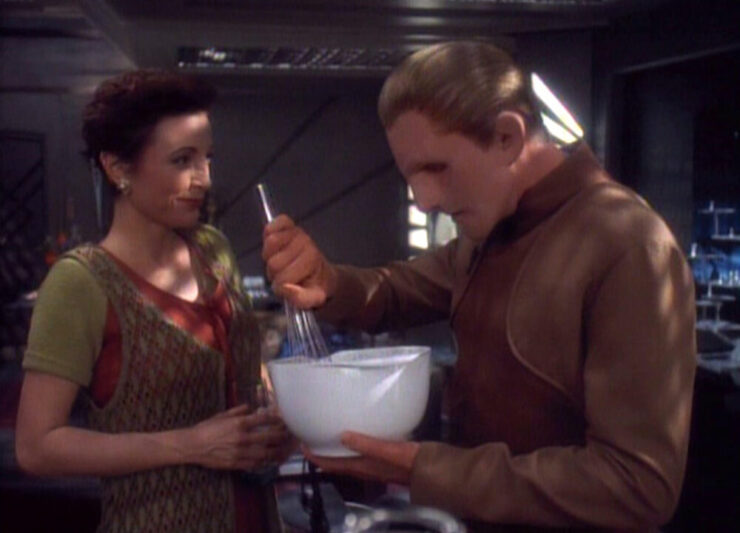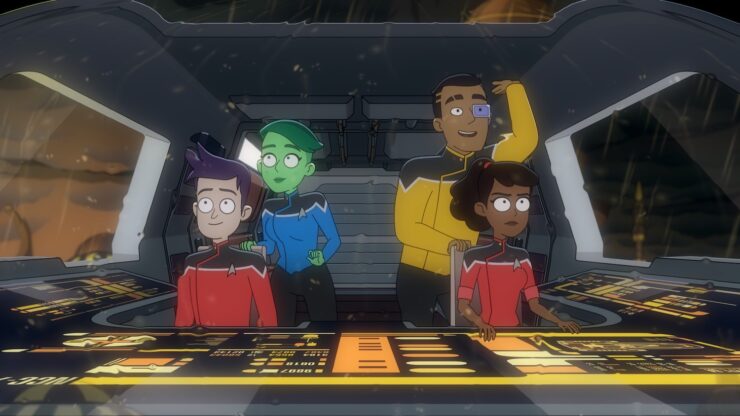“Far Beyond the Stars”
Written by Marc Scott Zicree and Ira Steven Behr & Hans Beimler
Directed by Avery Brooks
Season 6, Episode 13
Production episode 40510-538
Original air date: February 11, 1998
Stardate: unknown
Station log: Kira reports to Sisko that the Defiant has found no sign of the Cortez, lost while patrolling the Cardassian border. The captain was an old friend of Sisko’s, which makes him less than enthusiastic about his father Joseph visiting the station. Sisko doesn’t know how much more he can take, how many more friends he can lose. Joseph tries to comfort him, then goes off for a dinner date with Jake. Sisko talks with Yates, failing to convince her to cut back on her cargo runs for fear of Jem’Hadar attack.
Sisko also sees a man in a suit and hat and glasses (who looks a lot like Odo), as well as a man in a New York Giants baseball uniform (who looks a lot like Worf), but nobody else sees them. He follows the latter into a cabin, only to find himself on a street in 1953 New York City, where he promptly is hit by a cab. He wakes up in the infirmary, surrounded by Yates, Joseph, and Jake. Bashir says he’s got odd synaptic patterns, similar to what he experienced when the wormhole aliens gave him visions of Bajor.
And then Sisko’s back in New York, buying a copy of Galaxy Magazine from a news vendor (who looks a lot like Nog), and Sisko himself is wearing glasses, a suit, and a hat. His name is Benny Russell, and he meets up with Albert Macklin (who looks a lot like O’Brien) on the way to the office. Both of them are staff writers for the science fiction magazine Incredible Tales.
They arrive at work, where writer Herbert Rossoff (who looks a lot like Quark) and editor Douglas Pabst (the one whom Sisko saw earlier) are arguing over donuts, the latest in a series of arguments between those two. The husband-and-wife team of Kay and Julius Eaton (the former writes as K.C. Hunter to hide her gender) observe and make amused commentary. Once that’s over, and Pabst keeps Rossoff from quitting (again), artist Roy Ritterhouse (who looks a lot like Martok) comes in with some illustrations, which each of the writers takes as their assignment for the next issue’s story.
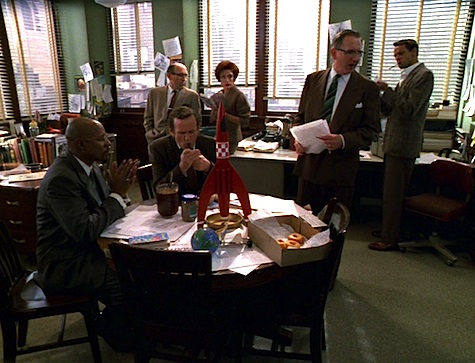
One of Ritterhouse’s drawings looks a lot like Deep Space 9. Russell is utterly captivated by the image and he takes it.
Pabst also says that their readers want pictures of the authors, and he also says that Kay and Russell can sleep late that day. Kay bitterly complains that heaven forfend anyone know that a woman is writing, and a Negro doing likewise would be just as bad from the publisher’s perspective. Russell angrily cites several Negro writers who are publicly known to be black—W.E.B. DuBois, Richard Wright, Langston Hughes, Ralph Ellison, and Zora Neale Hurston (who’s also female)—but Pabst says those guys write for liberals and intellectuals. The readers of Incredible Tales want to know that their writers are “as white as they are.” Rossoff is the most vocally disgusted, but everyone’s pretty displeased about it.
On his way home, Russell is harassed by two detectives, Burt Ryan (who looks a lot like Dukat) and Kevin Mulkahey (who looks a lot like Weyoun), who assume that he works as a janitor or something. When he comes out of the subway in Harlem, he passes a preacher (who looks a lot like Joseph) who talks to Russell directly and mentions the Prophets several times amidst his Bible thumping.
Sitting at his typewriter in his small apartment, Russell starts to write his story, which stars Captain Benjamin Sisko. At one point, he sees his reflection in his window—but his reflection is Sisko…
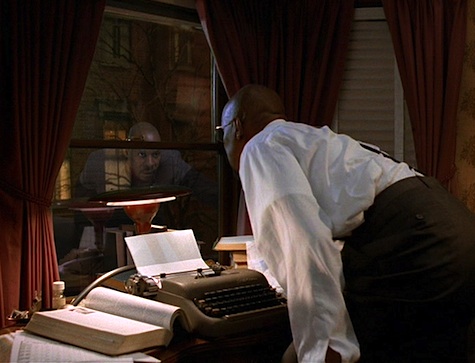
The next morning he goes to a diner for breakfast, where he’s served by his fiancée, Cassie (who looks a lot like Yates). The owner is thinking of retiring in the next few years, and she might be willing to sell to Cassie and Russell. Russell is reluctant—he’s a writer, not a diner owner, but Cassie doesn’t see that as sufficiently lucrative.
Their discussion is interrupted by the arrival of the baseball player from earlier, Willie Hawkins. He and Russell have a semi-friendly rivalry going over Cassie, though Cassie makes it clear that her heart belongs to Russell.
Hawkins then goes to greet his adoring public (smitten women and kids who want autographs), and Russell is joined by Jimmy (who looks a lot like Jake). He tries to sell Russell a watch that he “found.”
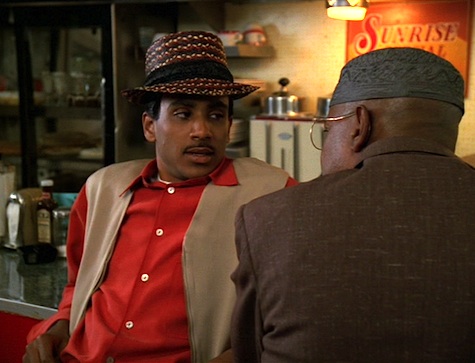
Everyone in the Incredible Tales office reads Russell’s story, called “Deep Space Nine,” and everyone loves it, even the new secretary Darlene Kursky (who looks a lot like Dax). Kay says she really likes the Major Kira character—a real “tough cookie”—and Russell briefly sees her as Kira. However, Pabst says he can’t print a story with a Negro captain. Rossoff and Russell are both livid, but Pabst insists he’s not a crusader, he’s not trying to change the world, he’s an editor of a magazine who answers to a publisher and distributors, and they can’t handle a Negro captain. Pabst will only print it if he changes the protagonist to a white guy. By way of apology, Pabst assigns him a novella that he’ll put on the cover.
Russell drowns his sorrows at the diner. Jimmy says he knew that colored people in space would never fly. “Only reason they’ll ever let us in space is if they need someone to shine they shoes.” Cassie, meanwhile, thinks this may be God’s way of saying he should give up writing and go into the restaurant business. When Hawkins puts a hand on his shoulder and asks if he heard the game last night, Russell sees Worf in full Klingon armor, and it scares the crap out of him.
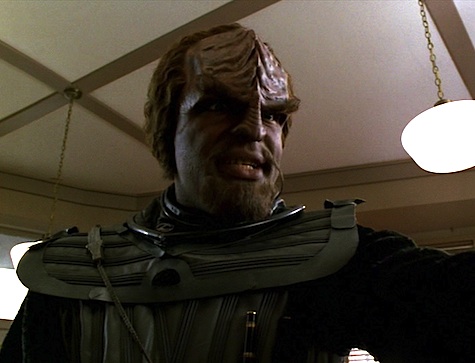
Again, Russell meets the preacher, who urges him to walk in the path of the Prophets. He goes home and writes more stories about Captain Benjamin Sisko, colored captain. He forgets all about his date with Cassie, and she shows up at his apartment around midnight. They dance a bit—but as they dance, they’re in Sisko’s quarters on DS9 and Cassie looks like Yates.
Pabst is livid when Russell shows up with, not the novella he was assigned, but six more Ben Sisko stories, after he refused to publish the first one. Julius suggests printing them all with a private publisher, a boutique edition of 50-100 copies. Kay points out that writing it in chalk on the sidewalk would garner a bigger audience. Macklin then suggests making it a dream, and Kay jumps on that, saying it can be a shoe-shine boy or a convict, someone dreaming of a better future. Rossoff thinks that it guts the story, but Julius thinks it’ll be more poignant. Russell agrees to make that change, saying that it’s better than chalk on the sidewalk, and Pabst is then willing to publish it.

A happy Russell bumps into Jimmy on the street, but he’s distracted, not even taking Russell up on his offer to buy him lunch. Undaunted, Russell goes to the diner and interrupts Hawkins’s latest attempt to impress Cassie with his hitting prowess by saying that they bought the story, and at three cents a word. He takes her out to the Rendezvous Club, where they dance the night away and he sings to her.
On their way home, they encounter the preacher, who cautions that joy and despair go hand in hand, and he also grabs Russell’s ear the same way Bajoran clerics do.
Then they hear gunshots. Jimmy’s been shot dead by Ryan and Mulkahey, allegedly for breaking into a car. When Russell expresses displeasure at his friend being shot for so minor a crime, he gets the crap kicked out of him for his trouble. During the beating Ryan becomes Dukat and Mulkahey becomes Weyoun.
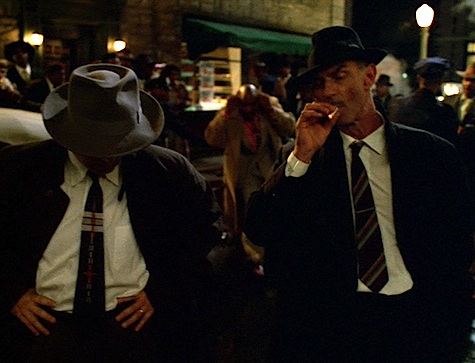
Weeks later, Russell is finally well enough to go into the office, which is good, as this is the day the issue of Incredible Tales with “Deep Space Nine” is due back from the printer. He limps into the office with a cane, and learns that Macklin has sold a novel to Gnome Press. The celebration about that is short-lived when Pabst arrives without a magazine. Mr. Stone, the publisher, had the entire run pulped because it “didn’t live up to the high standards,” which is code for “we can’t print a magazine with a colored hero.” To add insult to injury, Stone has instructed Pabst to fire Russell.
That’s the straw that breaks his back. Russell has a complete mental breakdown, and he’s taken away by doctors.
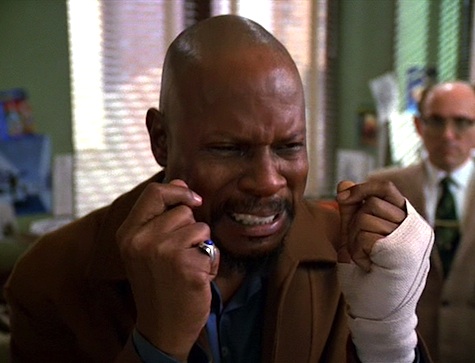
In the ambulance, he is wearing Sisko’s uniform, but still has his glasses and watch on. The preacher is in the ambulance, telling him that he is the dreamer and the dreamed.
And then Sisko wakes up in the infirmary, having been unconscious for only a few minutes, but the synaptic issues are all gone, to Bashir’s confusion.
Later, Joseph visits Sisko in his quarters. Sisko has decided to stay the course, to keep fighting, even if it’s hopeless. He also wonders if Russell was real and he’s the figment of a writer’s imagination.
The last image is of Sisko looking out the window of his cabin, seeing the reflection of Benny Russell.
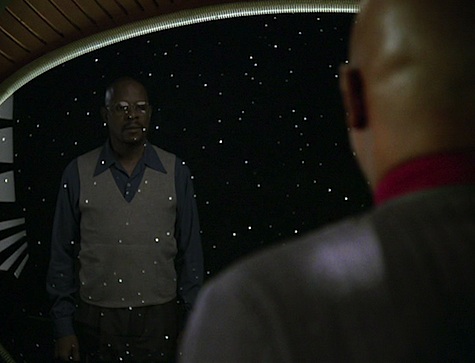
The Sisko is of Bajor: Russell has only been writing professionally for a few years. Prior to that, he was in the Navy. He also wrote things there (and based on the tie-in fiction, also wrote some radio scripts when he was younger), but he dismisses what he wrote then to Cassie as “amateur.”
Don’t ask my opinion next time: Kay has to write as K.C. Hunter, a common practice among female genre writers to avoid letting people know their sex. Others who did this were C.L. Moore and original series screenwriter D.C. Fontana (not to mention Star Trek novelists A.C. Crispin and J.M. Dillard). She’s also the one who fights most passionately for Russell’s stories to be printed. (Rossoff is louder and more obnoxious about it, but the character is naturally combative and resentful of authority. Kay’s passion is a bit more legitimate.)
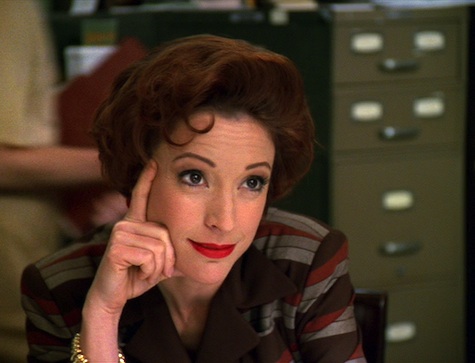
The slug in your belly: Darlene thinks the woman with the worm in her belly is “gross—but interestin’!”
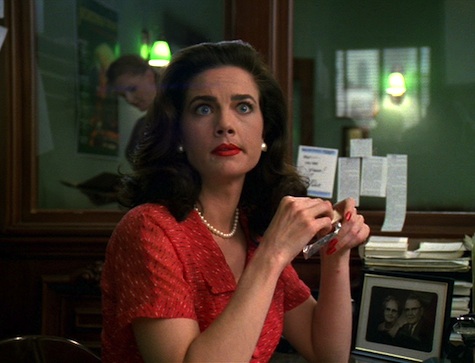
There is no honor in being pummeled: At one point, Cassie asks Hawkins why he continues to live uptown, but Hawkins bitterly says that the white players barely tolerate playing with him—living with them is a step too far. Besides, in Harlem, he’s a star; in a white neighborhood, he’s just some colored boy who can hit a curveball. It’s the only time the struttin’ Hawkins is at all bitter.
Preservation of mass and energy is for wimps: Pabst tries very hard to balance the needs of the magazine versus the needs of his writers, and doesn’t always succeed. While it’s to his detriment that he rejects “Deep Space Nine” initially, he does allow the others to talk him into it as a dream story, even giving Russell a higher word rate. But in the end, he has to do what his boss tells him to do.
Rules of Acquisition: Rossoff is a loudmouth and an agitator, for all that he’s pretty much right about everything he says. He’s dismissive of Macklin and Julius’s talents, disdainful of Kay’s story choices, and is constantly crawling up Pabst’s ass. When Pabst accuses him of being a Communist (by saying he’s “been angry ever since the day Josef Stalin died”), a very serious and dangerous insult in 1953, Rossoff tries to physically assault Pabst.
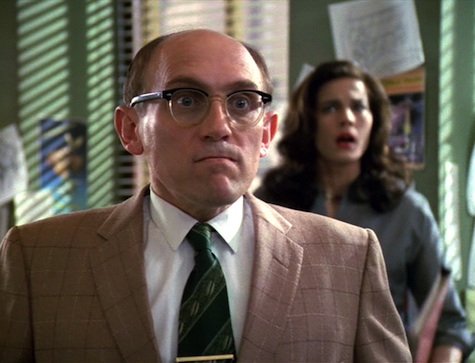
No sex, please, we’re Starfleet: Hawkins is very much a player, constantly hitting on Cassie despite her multiple rejections. When Russell leaves the diner saying he’ll pick Cassie up at ten, Hawkins immediately asks what she’s doing until ten. “Whatever it is,” she replies tartly, “I won’t be doing it with you.”
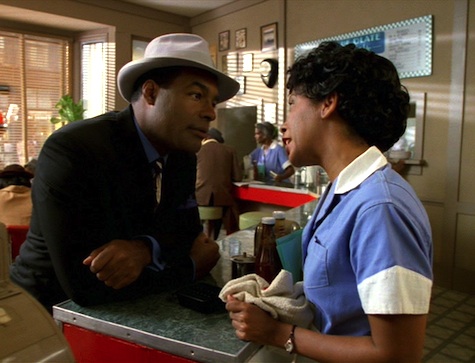
Keep your ears open: “If the world’s not ready for a woman writer, imagine what would happen if it learned about a Negro with a typewriter. Run for the hills! It’s the end of civilization!”
Rossoff’s sarcastic reply to Pabst saying that Russell and Kay’s pictures won’t accompany their stories.
Welcome aboard: Many of the show’s recurring regulars appear, albeit not as themselves (except briefly in flashes in some cases): Marc Alaimo and Jeffrey Combs play Ryan and Mulkahey, Aron Eisenberg plays the news vendor, and J.G. Hertzler plays Ritterhouse. Penny Johnson and Brock Peters also appear, both doing double duty, the former as both Yates and Cassie, the latter as both Joseph and the preacher.
The regulars all play roles in the 1950s setting as well. In the case of Rene Auberjonois, Armin Shimerman, and Colm Meaney, they only appear as Pabst, Rossoff, and Macklin, with Odo, Quark, and O’Brien not appearing at all in the episode. Avery Brooks doubles as Russell, Nana Visitor as Kay, Alexander Siddig as Julius, Michael Dorn as Hawkins, Terry Farrell as Darlene, and Cirroc Lofton as Jimmy.
Trivial matters: Incredible Tales was based on other magazines of the era that published science fiction, two of which, Galaxy Magazine and Astounding Science Fiction, are mentioned by name. The various folks at the magazine are all at least loosely based on real-life SF writers: Russell on Samuel R. Delany, Rossoff on Harlan Ellison, the Eatons on Henry Kuttner and Catherine Moore (a.k.a. “C.L. Moore”), and Macklin on Isaac Asimov (even selling his first novel about robots to Gnome Press just as Asimov sold I, Robot to that publisher). Pabst is at least partly modelled on John W. Campbell, one of the most influential editors and magazine publishers (and authors) in the field. In addition, Hawkins was inspired by Willie Mays, who was a hot young superstar center fielder for the New York Giants in 1953. (Well, actually, Mays missed the 1953 season because he was serving in the military, fighting in the Korean War, but still…) Russell’s bitter query of Hawkins as to why the Giants were mired in fifth place is accurate, as that was where the Giants finished that year.
Avery Brooks has often cited this as his favorite episode, and it was his choice for the Star Trek Fan Collective: Captain’s Log collection.
The covers for Galaxy, Astounding, and Incredible Tales that were seen use matte paintings from the original series: respectively, Starbase 11 from “Court Martial” (and the issue has a story in it with that title, written by “Samuel L. Cogley,” the name of Kirk’s lawyer from that episode), Eminiar VII from “A Taste of Armageddon,” and Delta Vega from “Where No Man Has Gone Before.” The stories in Incredible Tales are all original series references: “The Cage” by “E.W. Roddenberry,” listed as the author of Questor and billed as the first of a new series (it was the original pilot…); plus “The Corbomite Maneuver” by Jerry Sohl (with illustrations by Matt Jefferies), “Journey to Babel” by D.C. Fontana, “Where No Man Has Gone Before” by Samuel Peeples, and “Metamorphosis” by Gene L. Coon.
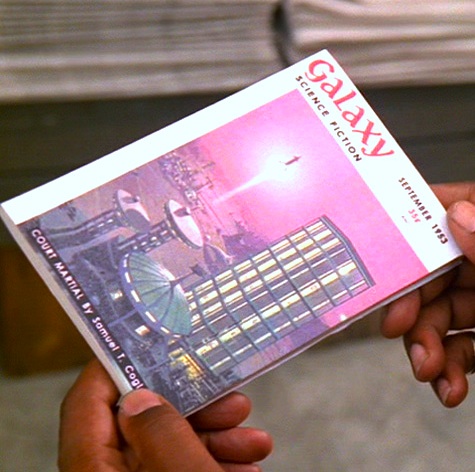
This is the only time in any of their many Star Trek appearances that Michael Dorn, Jeffrey Combs, Aron Eisenberg, J.G. Hertzler, and Armin Shimerman appear without any makeup or prosthetics. It’s only the second time (after “Time’s Arrow”) where Marc Alaimo so appears.
Casey Biggs was supposed to appear in this episode, but was working in New York and couldn’t get away. He will appear when the show revisits Russell in “Shadows and Symbols” at the top of season 7.
The “Trill Building” is a double joke, a play on both Dax’s species name and the famous Brill Building in Times Square in New York.
This episode aired in February, which is Black History Month. This was not intentional, simply a happy coincidence.
The music playing during Russell’s argument with the news vendor is “The Glow-Worm” by the Mills Brothers. After they leave the Rendezvous Club, Russell sings a bit of “Everything I Have is Yours” to Cassie.
One of the times when Rossoff is threatening to quit and packing the items on his desk, he packs an actual Hugo Award. The awards, named after Hugo Gernsback, the founder of Amazing Stories, the first magazine dedicated to “scientifiction,” in 1928, were in fact first awarded in 1953, and Star Trek has won four for Best Dramatic Presentation (“The Menagerie” two-parter, “City on the Edge of Forever,” “The Inner Light,” and “All Good Things…”). However, the actual award used was one of the two that Rick Sternbach won for Best Professional Artist in the late 1970s.
Also on Rossoff’s desk is a memo from Pabst saying that no one would believe that a cheerleader could kill vampires, a reference to Buffy the Vampire Slayer, on which Armin Shimerman had a recurring role as Principal Snyder.
The poster outside the Rendezvous Club advertises “Phineas Tarbolde and the Nightingale Women,” the latest in a series of references to the poem quoted by Gary Mitchell in “Where No Man Has Gone Before.”
This episode was novelized by Steven Barnes, who expanded considerably on Russell’s story (with portions taking place in 1940 as well), and also wrote an excellent afterword about the roles of African Americans in genre television and movies. The novel’s cover was in the style of the Incredible Tales covers, using the artwork seen in the episode designed by Ritterhouse to illustrate Russell’s “Deep Space Nine” story, as well as listings of other stories written by the characters seen in the episode (as well as one by “M.S. Zicree,” after Marc Scott Zicree, whose story this episode was based on). It was the last mid-season Trek episode to receive the novelization treatment, as all further novelizations were of season premieres and season enders (sometimes both at the same time, as with Enterprise’s “Shockwave”), as well as movies.
Besides the followup in “Shadows and Symbols,” Russell’s story is continued in various stories and novels, including Unity by S.D. Perry, Warpath by David Mack, Plagues of Night and Raise the Dawn by David R. George III, and most notably in the brilliant “Isolation Ward 4” by Kevin G. Summers in Strange New Worlds IV. In addition, a younger Russell is seen in George’s Provenance of Shadows, “Captain Proton and the Orb of Bajor” by Jonathan Bridge in SNW4 (as the author of a Captain Proton radio play from 1938, using the holodeck program favored by Paris and Kim on Voyager), “When the Stars Come a-Callin’” by Ben Raab & John Lucas in WildStorm’s Star Trek Special graphic novel (a prequel to this episode, showing how Russell came to work for Incredible Tales), and, most amusingly, in Captain Proton: Defender of the Earth, a short novel by D.W. “Prof” Smith (really Dean Wesley Smith), which was presented as a magazine from the early 1930s, complete with a letters page, which included a letter from a teenager named Benny Russell who said he’d some day write stories like the Captain Proton ones himself.
Bashir notes that Sisko’s synaptic patterns are the same as they were when he was receiving visions in “Rapture.” Yates immediately asks if he needs surgery again, as he did in that episode.
Walk with the Prophets: “Benny Russell is dreaming of us.” It’s very easy to forget now how radical Star Trek was in 1966.
At the time the show went on the air, people were watching news stories about a war being fought against people who looked like Mr. Sulu, and civil rights unrest from people who looked like Lieutenant Uhura, and we were all living in fear of being bombed into oblivion by people who sounded like Mr. Chekov. Yet there, in a depiction of the future, we had an Asian guy, a black woman, and a Russian man all working happily alongside the white folks (not to mention the pointy-eared alien). More to the point, though, nobody drew attention to it. The only one of the three whose heritage was a factor was Chekov, and then only for a running gag about how Russians “inwented” everything, something not considered important by anyone else. We knew Sulu loved botany and fencing and firearms, we knew Uhura loved music, but those were considered more important than even mentioning their race.
DS9 was as important in its own way by having an African-American lead, not to mention an Arab supporting character. Again, that fact wasn’t important, and up until this episode is never brought up in the case of either character. (The closest we came was casting an Arab-American activist as Bashir’s mother.) Sisko’s engineering background and love of cooking is more important than the color of his skin in the 24th century.
Back around 2000 or so, Pocket Books editor John Ordover decided to try an experiment. There had been some online interest from some readers about a Captain Sulu novel, picking up on Star Trek VI establishing that Sulu was in command of the Excelsior, and John wanted to see how widespread that interest was (especially given the poor sales on a previous Sulu solo novel, The Captain’s Daughter by Peter David). He called for a letter-writing campaign for people to write physical letters requesting a Captain Sulu novel, and if he got enough, he’d do it.
As it happens, he didn’t reach the stated goal, although another editor, Marco Palmieri, was more than happy to do two Captain Sulu novels (both by Andy Mangels & Michael A. Martin, the Lost Era novel The Sundered and the Excelsior novel Forged in Fire) in 2003 and 2007 without anybody writing any letters. But I was given the opportunity to read some of the letters that people sent, and I was blown away. The importance of the Uhura character has gotten plenty of press, from Dr. Martin Luther King Jr. famously asking her not to quit the show because of how important her being there was, to the litany of black women from Whoopi Goldberg to Dr. Mae Jemison who cited Uhura as a major influence on their lives. In contrast, Sulu doesn’t get anywhere near the same press, but to Asian Americans he was just as important a symbol as Uhura was to African Americans.
And, as Steven Barnes eloquently stated in the afterword to his mostly brilliant novelization of this episode, Sisko is a hugely important symbol for African Americans, an even bigger step than Uhura, because black folks don’t get to be the lead nearly often enough. Just look at other successful genre shows of the past two decades: Agents of S.H.I.E.L.D., Angel, Arrow, Babylon 5, Battlestar Galactica, Buffy the Vampire Slayer, Continuum, Eureka, Farscape, Hercules, Lost Girl, Stargate SG-1/Atlantis/Universe, Warehouse 13, Xena, The X-Files, to name but a few that spring to the top of my head—plus, of course, the other three Star Trek spinoffs. In each and every one of those, the primary lead is white, except for Galactica where he’s played by the Latino Edward James Olmos (though his son is played by the incredibly white Jamie Bamber, just to confuse the issue). African Americans can be the sidekicks, the secondary leads, the clever advisors, the muscle—but Sisko stands out as a lead.
People who make television shows are still just as scared as Douglas Pabst.
And that’s why this episode is important. We see so many aspects of how far humanity has to go to get to the egalitarian 24th century. The era picked was a good one. It predates the ugliness of Civil Rights unrest (not to mention the antiwar movement) of the 1960s and 1970s, but postdates things like a woman’s right to vote, the integration of the armed forces, and the integration of sports. It’s an era where progress is evident, but it hasn’t progressed nearly far enough. Yes, Willie Hawkins can play for a major-league team, but that’s only been the case for six years, and he still can’t really leave his neighborhood. Russell and Kay can write for Incredible Tales, but they can’t have their picture next to their stories.
I particularly like how they don’t lose sight of the fact that it isn’t just racism that’s an issue. We’ve got the sexism that makes it necessary for ”K.C. Hunter“ to be Kay’s byline, we’ve got the fear-mongering of Pabst red-baiting Rossoff, we’ve got the utter brutality of Ryan and Mulkahey, who obviously receive no reprimands for their actions. Hell, the only person who even says anything when they assault Russell is Cassie.
(The only real flaw in Barnes’s novelization is his dismissal of Kay’s objection to not having her picture in the magazine: “What was a matter of ego for Kay was survival for Benny.” That seriously trivializes sexism, forgetting, among other things, that Kay was part of the first generation of women who were born with the right to vote, women having only been granted that right a scant 33 years previous.)
Russell bitterly says that wishing never changed anything, but he’s wrong (as he sorta-kinda learns at the end). The dreams of people like Russell, like Gene Roddenberry coming up with his multicultural bridge, like Nichelle Nichols sticking with a role that may not have been fulfilling, but which fulfilled something bigger, like Brandon Tartikoff at Paramount green-lighting a genre show with a black lead, something that has been vanishingly rare even now, are what are important and what will help effect change.
One other thing about this episode I want to mention is that, as a writer, I adore the scene where everyone bats ideas around, trying to make “Deep Space Nine” work as a story that Pabst can actually accept. It’s a fairly accurate rendition of your average writers’ gab session, throwing ideas around and trying to figure out ways to make a story work better. In an episode that gets so much right already—the fashions, the cars, the attitudes, the accents—that scene stands out in particular.
The acting in the episode is beyond superb. I still wince a bit when Russell has his breakdown, as Avery Brooks tends to overplay that stuff, but aside from that, it’s great. In particular Armin Shimerman, Cirroc Lofton, Rene Auberjonois, and Michael Dorn stand out, creating complex characters that they inhabit superbly—and final scene notwithstanding, so does Brooks. Plus, it’s always a joy when you put Brooks together with Brock Peters in a scene.
The 24th-century stuff is a bit weak. The lesson that Sisko must soldier on even in the face of awfulness is a bit sledgehammery, and the preacher’s mixing of Bajoran and Christian theology is unintentionally hilarious, but these are minor nits. This is one of Trek’s finest hours, reminding us not just of how far we can go, as Trek usually does, but of how we can get there.
Warp factor rating: 10
Keith R.A. DeCandido’s newest novel is Sleepy Hollow: Children of the Revolution, based on the FOX show that just started its second season, which you can preorder from Sleepy Reads or find in your local bookstore.










